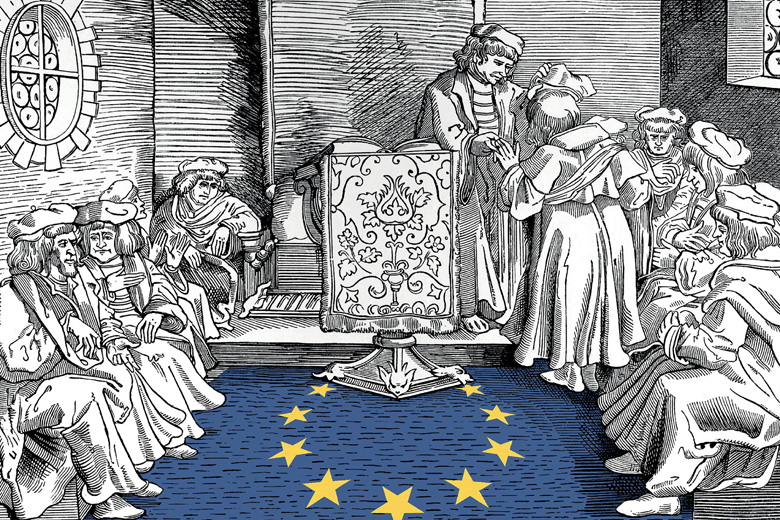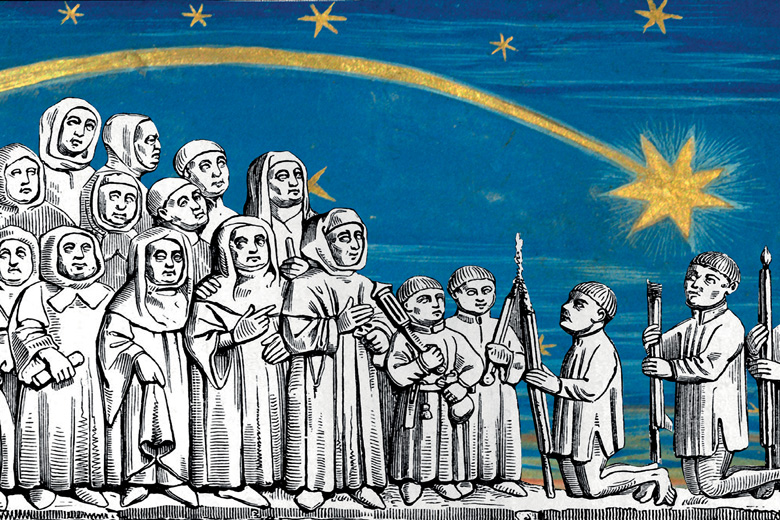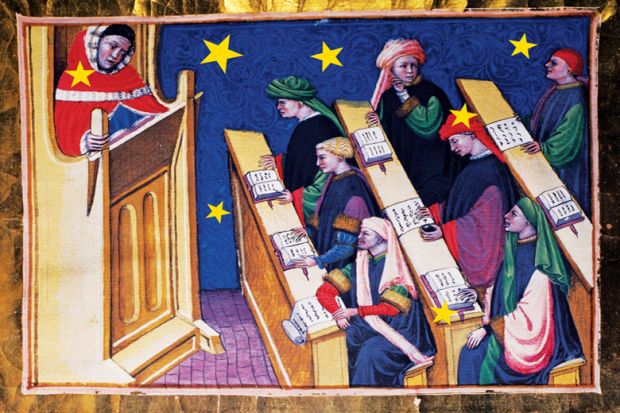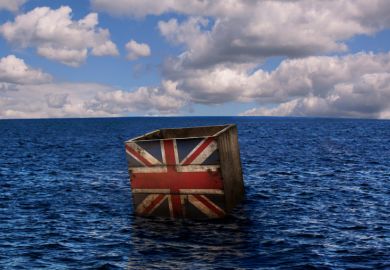Up and down the UK, academics have spent the past fortnight spinning through cycles of shock, disbelief, terror, outrage and denial in the wake of the country’s vote to leave the European Union. The Brexit debate has exposed deep divisions within the country at large, but it has also united the university community like no other issue in recent times.
The bodies representing universities – including the Russell Group, Universities UK and MillionPlus – were unanimous in their support for Remain. The vice-chancellors of 103 universities published an open letter three days before the vote, urging that remaining in the EU was “necessary for the UK to maintain its position as a highly skilled and a globally competitive knowledge economy”. The rest of the university community, which so often objects to this kind of instrumentalist argument, is for once voicing full-throated agreement. According to Times Higher Education’s own poll, nearly 90 per cent of those working in higher education wanted to stay within the EU. Nearly 70 per cent of UK students also planned to vote “in”, and university alumni strongly support Remain. In all likelihood, the universities are the most uniformly and passionately pro-European constituency in the country.
How, then, to account for this remarkable unanimity? Economic self-interest is always the first explanation invoked in our neoliberal age. The UK is one of the chief beneficiaries of EU research funding. Up to 2013, for instance, it received a larger share of Framework Programme 7 funding (15.1 per cent) than any other country besides Germany, as well as 22 per cent of all funding granted by the European Research Council: double the rate of the UK’s contribution to the EU budget as a whole (11.5 per cent). EU sources account for 10 per cent of the UK’s academic research funding, including large-scale consortia and high-risk, high-gain international research projects for which there are no other funding streams. That’s a powerful and simple argument, of precisely the kind that should work well in a referendum debate. But it didn’t win the debate, and it’s not the whole story. Wales and Cornwall are also huge net beneficiaries of EU funding, but they both opted to leave.
Materials for a richer explanation of Remain’s hold on the university can be found in the deep recesses of history. Simply put, the university, in origin, is not a national institution. In fact, most of Europe’s oldest universities are far older than the nation states in which they are currently located. When the first university was founded (traditional date: 1088), Bologna was a semi-autonomous civic commune near the southern boundary of the Holy Roman Empire. By 1500, a dozen further universities had been founded within the still fragmented Italian peninsula, in independent republics, the Papal States and the kingdom of Naples.
Elsewhere, the situation was similar. The oldest university in modern Spain (Salamanca, 1134) was founded in the kingdom of Léon, which occupied the northwestern corner of the Iberian peninsula, including parts of modern Spain and Portugal. Alcalá (1293) and Santiago (1495) were established within the kingdom of Castille; Barcelona (1450) and Valencia (1499) in the kingdom of Aragon.
The oldest universities in the Czech Republic (Prague, 1348), Austria (Vienna, 1365), Germany (Heidelberg, 1386), Belgium (Leuven, 1425) and Switzerland (Basel, 1460) were all established within territories subject to the Holy Roman Empire, and so were scores more before 1806. The oldest universities in Scandinavia, Uppsala (1477) and Copenhagen (1479), appeared in a period in which Sweden and Denmark were united in the Kalmar Union. The oldest universities in Europe’s northeastern and southeastern corners – in Estonia (Tartu, 1632), Finland (Turku/Helsinki, 1640) and Croatia (Zagreb, 1669) – were established within Sweden’s Baltic and Austria’s Balkan empires. Scotland’s ancient universities – St Andrews (1413), Glasgow (1451), Aberdeen (1495) and Edinburgh (1582) – were founded long before the formation of the UK in 1707, and may well survive to see its break-up.
So if the university was not a national institution in origin, what was it? The answer is that it was both profoundly local and broadly European. Universities emerged incrementally from monasteries, cathedral schools or groups of private masters, which came together to form guilds or corporations (the original meaning of “universitas”). But they quickly developed a symbiotic relationship with the highest authorities in Europe, which gave them legal status and reinforced their most valuable features. Within decades of its founding, Bologna began to draw students from across the continent. Without legal rights, these academic migrants were vulnerable to mistreatment either when travelling from place to place or while studying far from home. So, around 1155, the highest political authority in Latin Christendom, the Holy Roman Emperor Frederick I Barbarossa, issued a document entitled Authentica habita or Privilegium scholasticum, which bestowed on matriculated members of a university a legal status similar to that of the Catholic clergy. The most basic privilegium scholasticum allowed academics to be tried by their peers in university courts of their own. The result was a kind of transnational academic republic: a pan-European network of international enclaves within which students and teachers could live, study and work with some legal protection against victimisation by hostile locals.

As other universities sprang up, popes added new layers of international coordination. The supreme spiritual authority within Latin Christendom, responsible for uniformity of doctrine, the papacy helped (in virtue of its right to grant university statutes) to consolidate a structure of disciplines and degrees common to all universities. Studies commenced in a broad faculty of arts or philosophy, leading to the bachelor’s and master’s of arts degrees. From there, pathways diverged to one of the three higher faculties of theology, medicine or law, leading after a decade or more of study to the doctorate. Standardisation was further enhanced by canonical authorities for most subjects: Aristotle for philosophy, Galen for medicine, Justinian for civil law, and so on. Most fundamental was the use of Latin to mediate most learned exchange throughout Western and Central Europe, which also distanced this region from Greek and Arabic learning further east.
The result was one of the most successful institutions ever created in the West. The uniform structures of curricula and degrees made academic credentials transferable from one university or region to another. Within a century of Barbarossa’s intervention, Bologna was organised into 14 separate “nationes” to accommodate the students and teachers born (“natus”) in different regions. None of these coincided precisely with the 28 countries of the EU: alongside the likes of Romans, Lombards, Gauls, Normans and Catalans, the Germans included vast regions of Central and Northern Europe, while the English included the entire British Isles. Yet these “nations” are one of the sources from which modern conceptions of nationality derive. Their firm legal foundations likewise allowed these corporate bodies to endure indefinitely, despite the death of great teachers. Together, these arrangements spread structured debate on fundamental issues across an entire continent and sustained them without intermission for centuries. A civilisation had invented a means of collaboratively examining problems too difficult for individual scholars and local groups to solve.
These developments also spawned broader discussions in civil society. With the advent of the Renaissance, as printing presses and postal networks multiplied opportunities to interact and collaborate without meeting, some scholars abandoned the fixed structures of the university. Gradually, the pan-European academic republic gave rise to a parallel imagined community, the so-called republic of letters, responsible for many of the great intellectual developments of the 16th through 18th centuries, including the scientific revolution, the birth of modern philosophy and the Enlightenment. Composed almost exclusively of university alumni, the respublica litteraria retained and reinforced the cosmopolitanism of the European academic ideal, but replaced its legal privileges with a powerful emphasis on the virtue of free and open intellectual debate within a commonwealth of learning, exchanged its status-conscious hierarchies for a more informal and meritocratic ethos, and shifted its focus from the transmission of received learning to the generation of new knowledge. Between them, these pan-European learned communities articulated some of the fundamental values, ideals and practices underlying open science and scholarship today, and institutionalised them in a huge range of fundamental innovations, from the footnote and modern notions of authorship to the learned journal and academies of arts and sciences.
Deriving from these cosmopolitan institutions and ideals, Europe’s greatest contributions to human culture and learning are transnational in scope. A case in point is the most striking intellectual development of the early modern period: the overturning of the geocentric cosmology and physics of Aristotle and Ptolemy.
Like much Greek science, Ptolemy entered the world of medieval European learning partly via Arabic translations of his works produced in cosmopolitan centres in Sicily and Toledo. When a Greek version became available in Europe, translations were made by George of Trebizond (from the Greek island of Crete, at the time a Venetian colony) and a German astronomer in Vienna, Johannes Regiomontanus. Their work became fundamental, in turn, for Nicolaus Copernicus, who returned to his native Poland after studies in Bologna, Padua and Ferrara to provide the first full mathematical formulation of a heliocentric cosmology.
Observational evidence with which to test and refine the Copernican hypothesis was then sought by Tycho Brahe, a Danish nobleman working initially on the island of Hven (now part of Sweden), and then within the court of the Austrian emperor in Prague. His assistant, Johannes Kepler, from Swabia in Germany, published his results in Ulm and used them to formulate his famous three laws of motion. Meanwhile, the Tuscan mathematician Galileo Galilei had made the first telescopic observations of the Moon, planets and stars, and was performing a brilliant series of experiments designed to provide a new physics consistent with the new cosmology. The French philosopher and mathematician René Descartes, working in the Dutch Republic, began shaping a new mechanistic philosophy around these results. All these innovations were further elaborated by Christiaan Huygens, a Dutch mathematician working in Paris. Finally, Isaac Newton, standing “on the shoulders of giants”, created a new synthesis not merely of the new physics and astronomy but also of the experimental and mathematical aspects of scientific method. His work then became a paradigm of Enlightenment rationality throughout Europe during the following century, thanks partly to the networks created around the Royal Society by the indefatigable labours of its first secretary, Henry (or rather Heinrich) Oldenburg, a native of Bremen.

This deep history has profound implications for the modern policymakers who must negotiate the UK’s new relationships with Europe. Given the cosmopolitan origins of the European university, British universities will thrive only when they are internationally connected. Despite the increasing importance of global networks, Europe is the UK’s primary partner in a huge range of highly innovative fields, thanks overwhelmingly to inspired policymaking in the EU. Even those leading the Leave campaign appear to understand this. In his first statement after the referendum, Boris Johnson insisted that the post-Brexit world would see “intensifying European cooperation and partnership in a huge number of fields”, beginning with “the arts, the sciences, [and] the universities”. Higher education leaders must ensure that this vision is pursued, even if Johnson himself is now excluded from these negotiations.
Meanwhile, European negotiators must remember that the process of European cultural and intellectual integration is far older and deeper than is commonly realised. Fully grasping that point requires another kind of Copernican shift. Viewed over nearly a millennium of history, Europe’s international network of universities is not merely a satellite of national states or transnational corporations. It is a galaxy of stars exercising part of the gravitational force that keeps European civilisation together. As such, it deserves a far more central place within European consciousness and identity.
As the Brexit result shows, identity matters as much as economic rationality. This is clear from the core dilemma at the heart of the EU. Economic union, the argument goes, requires monetary union. Monetary union, in turn, requires political union. But both economic and political union require cultural union. But on what basis can such persuasion succeed? Logically, it must be based on historical achievements, accomplishments, institutions and values that all Europeans share. Longer narratives of continental integration must be inserted into public consciousness alongside more familiar stories of national consolidation, and institutions must be reinvented that revive the tried and tested formulas of past success.
This is precisely what much EU university policy has attempted to do. The Erasmus programme, named after the figure at the heart of the first European republic of letters, attempts to rekindle the transcontinental student exchange typical of the pre-Reformation period. The equally well-named Bologna Process attempts to reinforce that mobility by re-establishing transnational academic credentials as well. The EU has also restored to European students and academics the right to live, work and study wherever they choose that they previously enjoyed for centuries.
The success of these policies, moreover, is evident even in the traumatic aftermath of the British referendum. The university community across the UK remains deeply committed to a European future. Since the university-educated proportion of the population is growing rapidly, time is on Europe’s side. The better-educated portion of the current population, below the age of 45, voted Remain by a larger margin than the worse-educated portion of the population, the over 45s, voted Leave. Indeed, if 16- and 17-year-olds had been allowed to vote (as they were in the Scottish independence referendum of 2014), or if 18- to 34-year-olds had voted in the same numbers as those over 65, the Brexit fiasco would be over by now. At the relatively superficial monetary and political levels, where the pace of integration has been artificially accelerated from the centre, the project of union is in difficulty. But at the cultural level – where the process is deeper, indigenous and decentralised – European integration is proceeding remarkably quickly.
Europe’s leaders need to hold their nerve, and keep faith with the 48.1 per cent of UK voters who share their vision. The UK’s decision to leave is not ultimately the result of a rising tide of Euroscepticism or anti-immigrant feeling. It is a wave of protest against the failure of the British government to rebuild communities far from London shattered by deindustrialisation and globalisation, to make those who profit from high finance pay for its failures, to build the houses and schools that any growing population needs, and to take responsibility for its mistakes rather than blaming them on foreigners.
After the frenetic activity of recent weeks, we need to step back, put these events in a much broader context, and agree to play the long game. Kingdoms rise and fall, unions wax and wane, but universities and the networks they create can outlast them all. European policymakers in the midst of this crisis need to practise the wisdom and patience of their predecessors: those far-sighted architects of European integration, the popes and emperors of the 12th century.
Europe must be more than 28 member states, reconfiguring themselves to serve international business. It also consists of other corporations, older and in some ways also wiser. Deep-rooted, indigenous traditions need to be generously fertilised and patiently cultivated in fair weather and foul. That is the best way to nurture the hardiest and most fruitful species of deep European integration.
Howard Hotson is professor of early modern intellectual history at the University of Oxford.
POSTSCRIPT:
Print headline: The stars are still aligned
Register to continue
Why register?
- Registration is free and only takes a moment
- Once registered, you can read 3 articles a month
- Sign up for our newsletter
Subscribe
Or subscribe for unlimited access to:
- Unlimited access to news, views, insights & reviews
- Digital editions
- Digital access to THE’s university and college rankings analysis
Already registered or a current subscriber?










